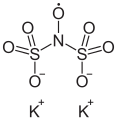Aminoxyl denotes a radical functional group with general structure R2N–O. It is commonly known as a nitroxyl radical or a nitroxide, however IUPAC discourages the use of these terms, as they erroneously suggest the presence of a nitro group. Aminoxyls are structurally related to hydroxylamines and N-oxoammonium salts, with which they can interconvert via a series of redox steps.
-
 The general structure of the aminoxyl radical
The general structure of the aminoxyl radical
-
 TEMPO, a commonly encountered organic aminoxyl radical
TEMPO, a commonly encountered organic aminoxyl radical
-
 Fremy's salt, an inorganic aminoxyl radical
Fremy's salt, an inorganic aminoxyl radical
Sterically unhindered aminoxyls bearing α-hydrogens are unstable and undergo rapid disproportionation to nitrones and hydroxylamines. Sterically hindered aminoxyls without α-hydrogens, such TEMPO and TEMPOL, and are persistent (stable) radicals and find use in a range of applications, both on the laboratory scale and in industry. Their ability to reversibly bind to other radical compounds makes them important as both spin labels and spin traps. They are used to selectively oxidise carbonyl groups via oxoammonium-catalyzed oxidations. They are also used as polymer stabilizers such as hindered amine light stabilizers or as transient reactive species in p-phenylenediamine based antiozonants. They are used both to form polymers via nitroxide-mediated radical polymerization and prevent their formation as polymerization inhibitors. Various other reagents, such as N-hydroxyphthalimide can also be converted into aminoxyl radicals as part of their chemistry.
See also
- Nitrone — structurally related, an N-oxide of an imine
References
- IUPAC, Compendium of Chemical Terminology, 2nd ed. (the "Gold Book") (1997). Online corrected version: (2006–) "aminoxyl radicals". doi:10.1351/goldbook.A00285
- Nilsen, Aaron; Braslau, Rebecca (15 January 2006). "Nitroxide decomposition: Implications toward nitroxide design for applications in living free-radical polymerization". Journal of Polymer Science Part A: Polymer Chemistry. 44 (2): 697–717. Bibcode:2006JPoSA..44..697N. doi:10.1002/pola.21207.
- Cataldo, Franco (January 2018). "Early stages of p-phenylenediamine antiozonants reaction with ozone: Radical cation and nitroxyl radical formation". Polymer Degradation and Stability. 147: 132–141. doi:10.1016/j.polymdegradstab.2017.11.020.